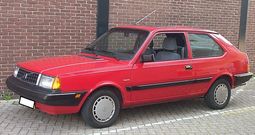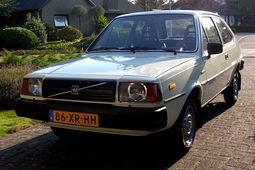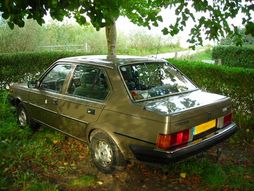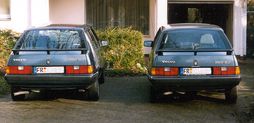The History Of Volvo 340

The Volvo 300 series was a rear wheel drive automobile sold as both a hatchback and (later) a conventional saloon from 1976-1991. It was launched in The Netherlands shortly after Volvo acquired a major stake in the passenger car division of DAF in 1973. The series consisted of the Volvo 340 (initially badged as the 343/ 345) and the Volvo 360 4 door saloon. The design of the series came from de Vries (internal designer)
The 300 series was unusual in having the gearbox mounted over the rear axle (which was of the De Dion tube type), with the 360 having the driveshaft enclosed in a "torque tube". The rear-mounted gearbox helped with weight distribution and handling but resulted in an unusually large transmission tunnel, especially by comparison with then-contemporary front wheel drive competitors such as the Mk. III Ford Escort and the Volkswagen Golf.
Overall, the 300 series was considered heavy and unrewarding to drive but reliable and safe by the standards of its day. However, early 360GLT versions were well regarded by more enthusiastic drivers, with the unusual gearbox location ensuring good weight distribution and unusually good balance and traction.
After building a series of compact cars, DAF sought a partner to bring its new larger model, codenamed P900 and intended to become the DAF 77, to market in 1970. Several manufacturers were approached, including Audi, BMW, and Volvo. Volvo was not originally interested due to the cost, but they were later persuaded by DAF's access to Renault engines. This helped Volvo expand its model line-up without the large expenditures associated with developing a new model. Building cars in the Netherlands also helped the Swedish Volvo to access the markets of the EEC, of which Sweden was then not yet a member.
Volvo purchased a one-third share in DAF in 1973, increasing to a three-quarters stake in 1975; the DAF company's name was changed to Volvo Car BV that year. Free of its passenger car division, DAF's commercial vehicle division, DAF Trucks, still operates today.
The Volvo 343 was introduced in 1976. DAF had already begun development of this car as a replacement for the Volvo (previously DAF) 66. It was fitted with a 1.4 litre Renault engine in the front and DAF's radical Variomatic continuously variable transmission unusually mounted in the rear, helping weight distribution. The car didn't sell well with this transmission on the "shifthappy" European market, and sales only really started to take off when a manual transmission from the 200 series was made available in 1979. A five-door model, the 345, was added in 1980. In around 1980 also larger wrap around bumpers were introduced. 1981 saw the addition of an additional engine option, the 2.0 litre B19A unit, again from the Volvo 240, only available with the manual gearbox. These models were designated the DLS and GLS, whilst the 1.4 litre engine was only available in L, DL and GL form. A more streamlined bonnet, grille and front lamp arrangement and slightly different fenders signalled a facelift in 1982, which also gave the car a new dashboard and revised interior.
The third digit designating the number of doors was dropped from model designations in 1983. The 343 DLS and GLS were renamed the 360, which arrived that year with two 2.0 litre engine choices, the 92bhp (69kW) B19A, and the fuel injected115bhp (86kW) B19E for the flagship model, the 360 GLT. The 360 model was available in five-door and three-door hatchback form, with four-door saloon models added in 1984, as were the 340's.
In around 1985 a further facelift was introduced. Amongst other small changes, wrap-around body coloured bumpers with the indicator repeaters attached to them were fitted. Instrumentation changed from Smiths units to VDO. The older Volvo red block engines in the 360 were upgraded to the low friction B200 unit. Capacities and outputs remained much the same. The carbed version was designated B200K and the Bosch LE-Jet fuel injected version is known as the B200E. Also, the manual 340 models were now available with the B172 Renault F-series 1.7 litre engine.
From 1987 on, incremental improvements in features and emissions control were made. Production of the 300 series ended in 1991, despite the fact it was supposedly replaced by the Volvo 440 in 1987.
A famous advertisement for the 300 series in the late 1980s saw a crash test dummy "come alive", and drive a 340 out of a second floor factory window, nose-diving into the concrete ground.
The 300 Series had a choice of three petrol engines; a 1.4, 1.7, and a 2 litre. The 1.4 litre B14 was a 72bhp (54kW) Renault C-series OHV pushrod unit, and for the DLS, GLS and 360 there was the B200 2 litre engine taken from the Volvo 240, with outputs varying from 95bhp (71kW) to 112bhp (84kW) . A new Renault F-series 80bhp (60kW) 1.7 litre OHC petrol engine (designated the B172) was introduced in the 340 during the late 1984 range facelift.
A diesel engine was added to the 340 models in 1986. This diesel was a Renault F series like the petrol 1.7, and was available with a 55bhp (41kW) 1.6-litre non-turbo engine only. These diesel models were never offered in right-hand drive form, and hence were never officially exported to right-hand drive markets such as the UK.
Like other Volvos, the 340 embodied many ground-breaking safety features which have since become standard on most cars.[citation needed]
While the car was fundamentally robust, the detail build quality was never up to the same standard of Volvo's larger, Swedish-built models, coupled to the fact that the early Variomatic cars proved to be particularly troublesome.[citation needed] The Volvo badge however ensured that the car had a strong middle-class following (often as a second car) particularly in the UK in the 1980s, being the nation's eighth best selling new car in 1982 and the tenth in 1983 and 1984. They are robust and mechanically simple (and therefore easy to maintain). Even the unpopular Variomatic transmissions are reliable given proper care. The rust protection was poorer than other Volvos, but the engines (especially the 1.4 and 2.0's) were quite durable.
An unusual feature of the car's design is the geometry of the rear axle. Two degrees of negative camber on the rear de Dion axle produces a similar stabilising effect as the expensive and complex Weissach axle launched by Porsche a year after the launch of the Volvo 343. The inherent stability of this design made the car popular with caravan owners, being voted Tow Car of the Year in 1985.[citation needed]
The Renault-sourced 1.7 litre engine suffers from a well-known problem where the carburettor mounting flange warps due to engine heat, causing a small air leak and subsequent running problems. This is easy, if expensive, to fix.
The Volvo 300 has experienced something of a renaissance in recent years with a number of very active websites across Europe. A strong, young following has developed attracted by a rear wheel drive car which is very cheap to buy, insure and relatively easy to work on. In the UK, despite being unsuitable for professional drifting, because of its low price, many 300s has found its popularity amongst the amateur drifting community known as "trampdrifting" which old bangers are modified to drift at a minimal cost and is discarded once it reaches its end of life.
It featured among the top 10 most popular new cars in the UK in 1982, 1983 and 1984, and was one of the UK's most popular imported cars of the decade.
It was not sold in North America.
Top Gear co-host Jeremy Clarkson has a long hatred for the 340. In one episode, he had one destroyed in a car compactor . In another episode, he intentionally crashed one against a tree as he pointed out Volvo's reputation for safety .
From Wikipedia, the free encyclopedia
More About Volvo 340




|